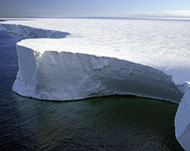Climate scientists await new satellite
Europe’s first spacecraft dedicated to the study of ice is scheduled to go aloft on Saturday as part of a heightened effort to gain insight into global warming.

CryoSat, a 711kg European Space Agency satellite, carries a radar altimeter that will scan the thickness of polar ice sheets and floating sea ice to a previously unattained accuracy of a centimetre per year.
If the launch from a base in northern Russia goes according to plan, climate scientists will gain a powerful new tool.
Like a canary in a coalmine, the Arctic sea ice that is CryoSat’s main focus could be an early indicator of big trouble for all of us.
Satellite data suggest that this ice cover has been shrinking at around 3% a year since the 1970s, although information about its thickness – a critical factor in how serious the problem could be – remains sketchy.
Arctic ice disappearing
Last month, US researchers said the Arctic ice cap is now at its smallest for more than a century.
“The year 2005 puts an exclamation point on the pattern of Arctic warming we’ve seen in recent years,” said Mark Serreze of the US National Snow and Ice Data Centre.
In August, a study published in the British journal Nature determined that the collapse of a huge ice shelf in Antarctica in 2002 had no precedent since the end of the last Ice Age 11,000 years ago.
The Larsen B-iceshelf, measuring some 3250km squared in area and 220m thick, broke away from the eastern Antarctic peninsula – a “hot spot” where temperatures have risen by around 2 degrees centigrade over the past half-century.
Difference of opinions
Greenhouse-gas negationists insist that such warming is part of a natural cycle in the planet’s orbit and inclination that has caused many climate shifts in the past.
Many scientists though shrug at such opinions.
 |
|
Scientific data suggest that the |
Barely a week goes by without a new study strengthening the conclusion that the warming is man-made – it comes from carbon-gas pollution from fossil fuels which store heat from the Sun instead of letting it radiate into space.
The northern polar ice cap is mainly floating sea ice whose loss would not affect global sea levels.
Some experts worry, though, that the onrush of cold freshwater would dramatically stop the conveyor belt of warm ocean currents that provide northwestern Europe with its balmy weather.
No problem?
The Antarctic ice cap lies mainly on rock above sea level. Eastern Antarctica, which covers 75% of the continent’s total land area, holds 85% of the world’s ice.
Its loss would be catastrophic, as it would drown small island states, delta regions and many coastal cities.
No one today sees any sign that this doomsday scenario will come to pass.
All the indications are that the East Antarctica icesheet is stable, and against all expectations a study published last year said the icesheet might even have thickened in recent years because of extra snowfall.
Such surprises highlight the many unknowns about the state of the polar icecaps.
Catch 22
One big worry is about “positive feedback” – the scientific term for a vicious circle. In other words, the loss of the ice makes local waters warmer, which in turn helps to melt more ice, and so on.
CryoSat is the first in a series of six ESA Earth Explorer satellites designed to explore key environmental problems.
Its 1000-day mission is scheduled to start with a launch at 1500 GMT on Saturday from Plesetsk, a once-secret Soviet base in the Archangel region.
The launch vehicle is a Rockot – a converted Soviet-era SS-19 ballistic missile with an additional Breeze-KM upper stage.